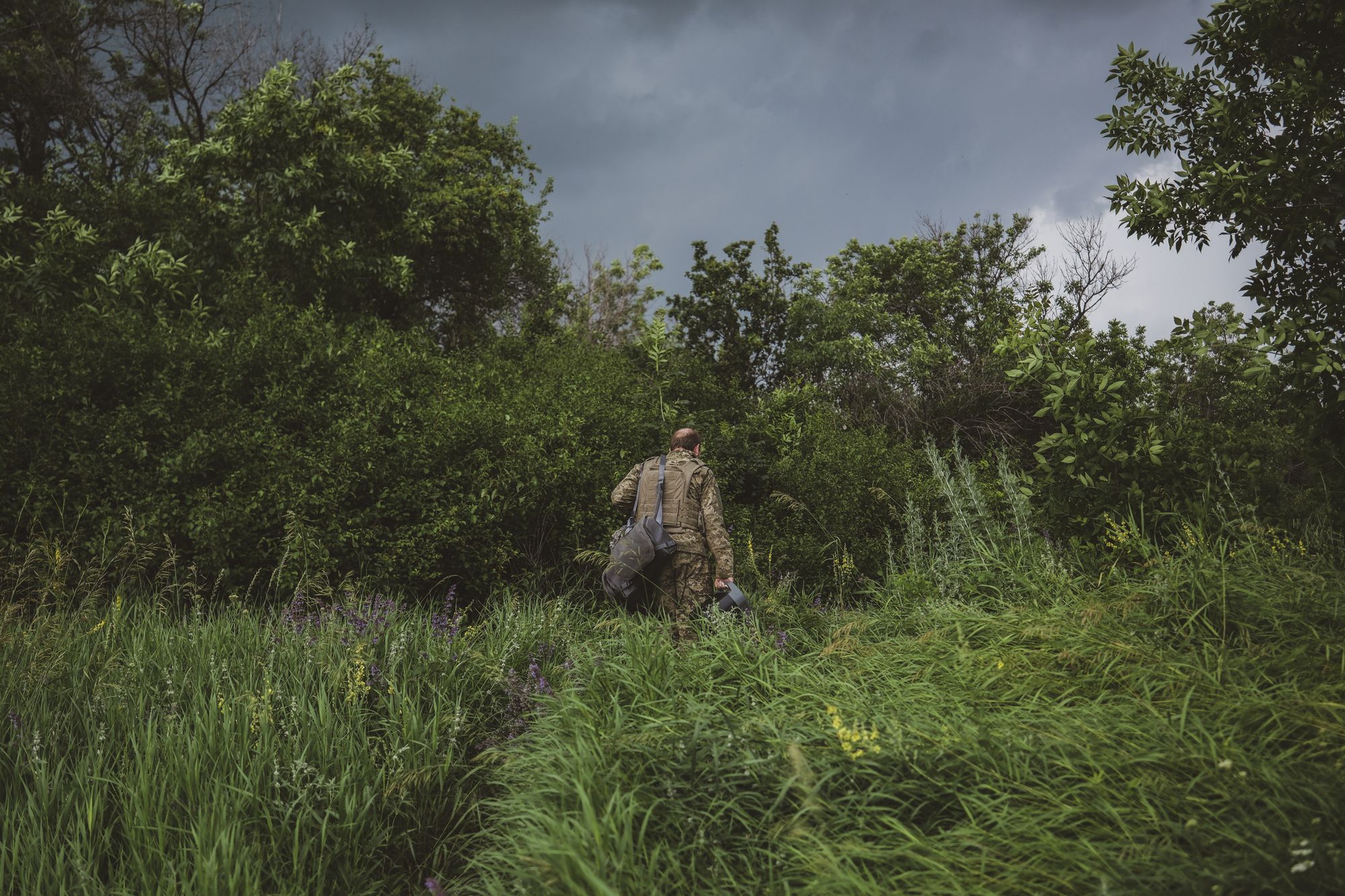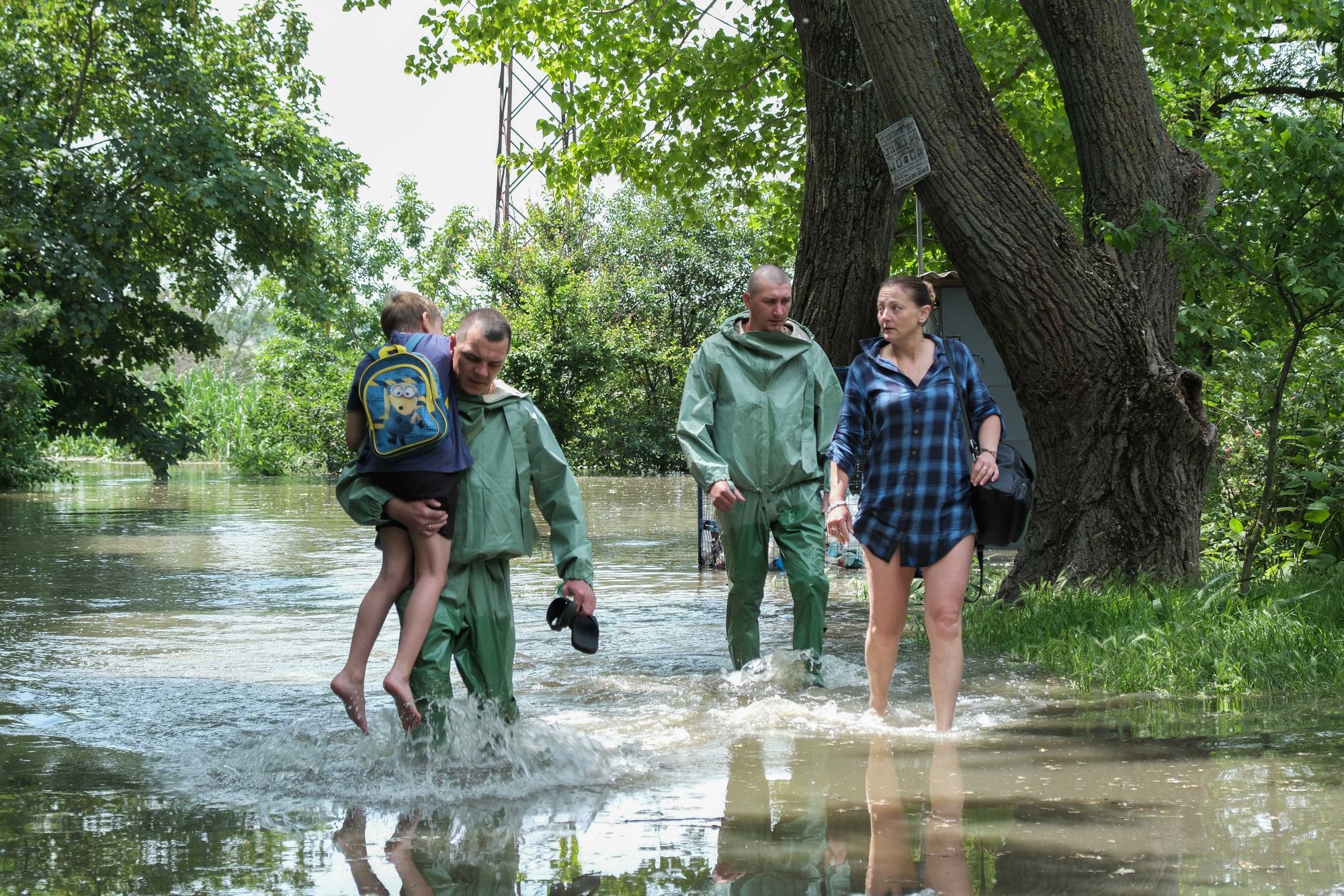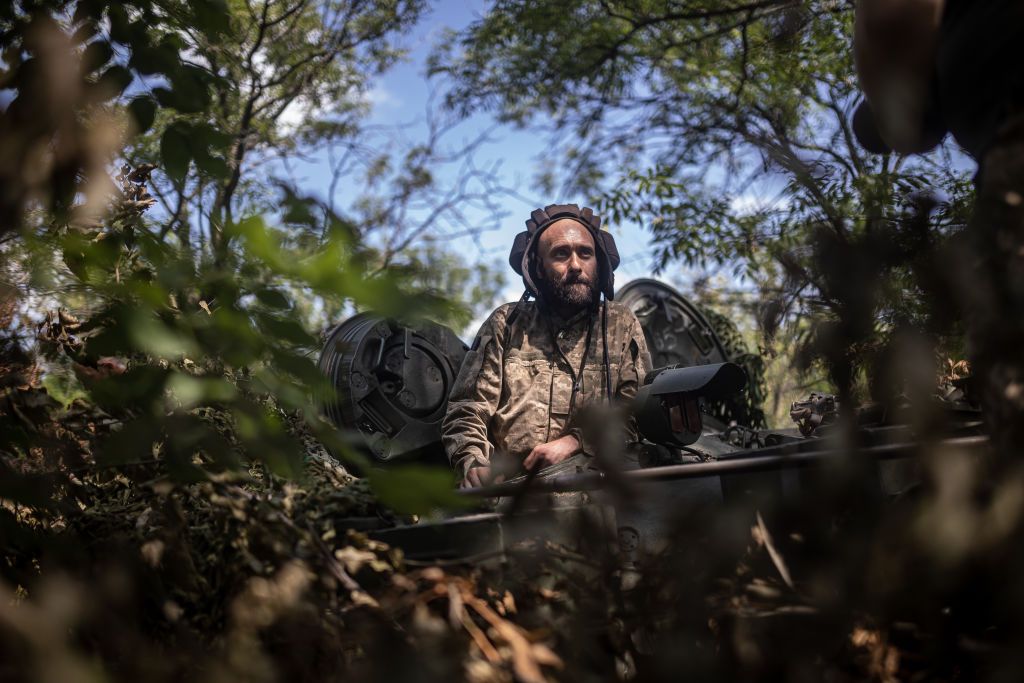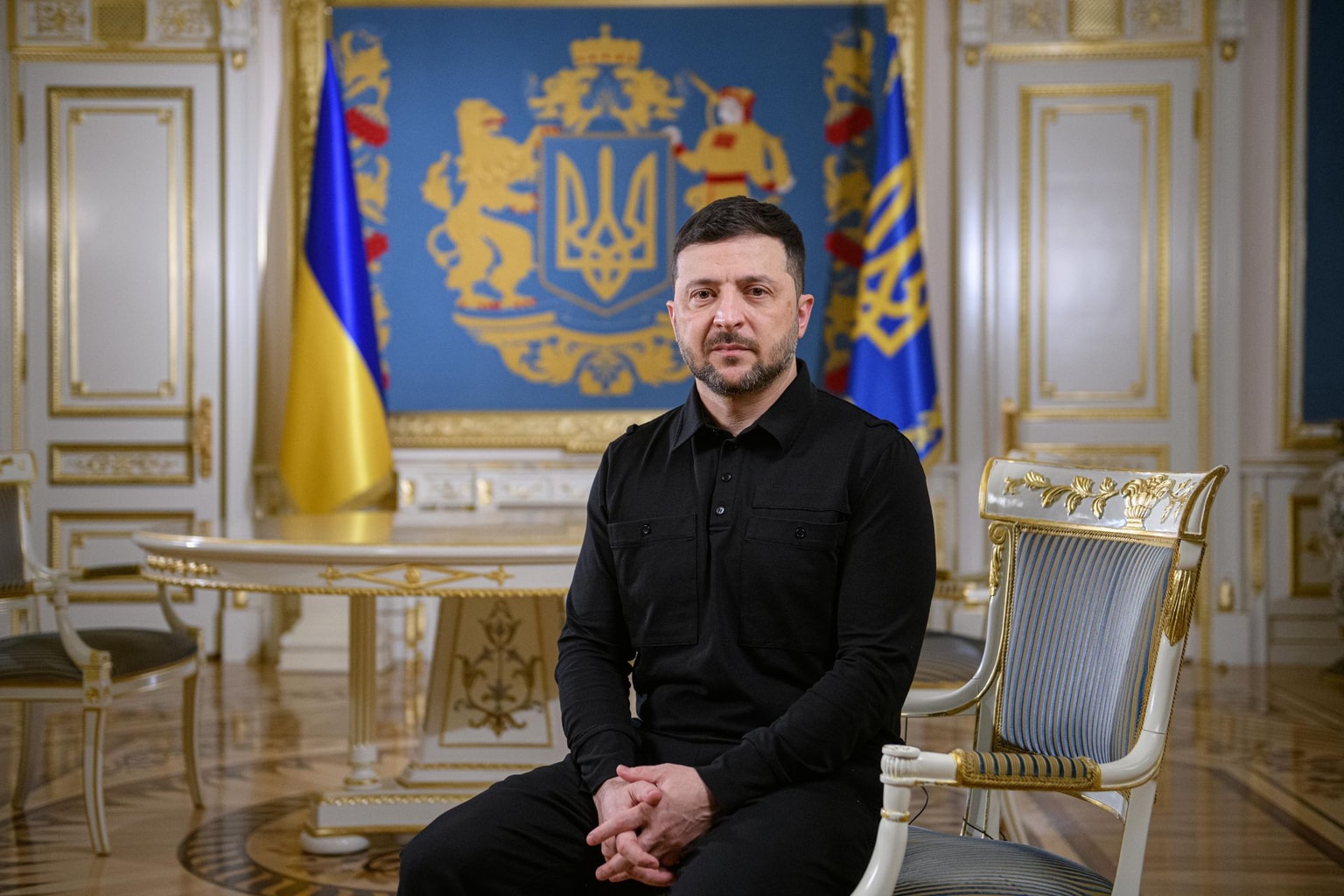Ukrainian troops regularly cross Dnipro River, probing Russian defenses in Kherson Oblast

Kherson Oblast – Ukrainian soldiers board a speedboat one by one. It sinks deeper into the water, weighed down by the men, their weapons, and equipment.
The soldiers at the stern push off from the riverbank with oars until, finally, they turn on the boat's engine, roaring into the darkness toward one of the islands that dot the Dnipro. They know this trip to the Russian-occupied side of the Dnipro River could be their last.
"It's the kind of trip that can end up very good or very bad," the unit commander, part of the 124th Territorial Defense Brigade, told the Kyiv Independent after one of these deadly missions, giving a rare glimpse of what goes on during these cross-river raids.

On Aug. 9, the Kyiv Independent's source in Ukraine's Armed Forces confirmed that Ukraine had successfully conducted a raid deep into Russian-held territories across the river.
The source, granted anonymity to speak freely about Ukraine's military operations, told the Kyiv Independent that Ukraine's military had taken 16 Russian soldiers as prisoners and brought them back to the government-controlled side of the river.
Probing attacks
Every week or so, the infantrymen of the 197th Bataillon – part of the 124th Territorial Defense Brigade – conduct secret, night raids into Russian-held parts of Kherson Oblast.
Their mission: to probe Russian positions and attack them in the hope of establishing a foothold on the bank's eastern side.
"We attack them where they least expect us," the unit's commander says.
Russian forces have been dug in on the river's eastern bank since November last year, when Ukrainian forces pushed them out of the part of the oblast west of the Dnipro River, including the southern city of Kherson.

Since then, the Dnipro has become a watery front line between Ukrainian forces and Russian-occupied territories – one that the commander and his men cross under cover of darkness to conduct their raids.
The latest such attack is said to have taken place on Aug. 8, with Ukrainian forces gaining a foothold near the village of Kozachi Laheri, some 27 kilometers northeast of Kherson on the eastern bank of the Dnipro.
According to the Kyiv Independent's source in Ukraine's Armed Forces, the team had pulled out from the east bank as planned.
Guerilla-style war
The raids have been going on for months.
"Our first task was to keep the Russians' attention on us and not the city (of Kherson)," the unit commander says.
"We were doing everything to keep them distracted so they wouldn't bomb the city," he says, adding that Kherson was almost quiet when his unit was actively patrolling the river to bait the enemy's artillery.
Smaller groups work better to cross the kilometer-wide waterway, the officer says.
"We come in small groups to f*ck them up."
Picking the team and preparing the attack can take up to four days. The team must be small to be as discreet as possible: A sniper to target the Russians from afar, a mortar soldier to shell their positions, two UAV pilots for reconnaissance and sometimes to attack with kamikaze drones, as well as a sapper-miner to lay mines or clear the ground.
Five soldiers are all the small speed boats can carry without being too slow or heavy.
"The most difficult part is getting there," the unit commander says. "The boats sometimes act funny, the engines can give up on you at any second, and you don't want to be stuck on the river in broad daylight."

Once the team has reached the other side and the boat is hidden in a safe place, there comes another ordeal.
"Marshes, f*cking marshes everywhere," the unit commander says.
The fighters need to walk for kilometers through mosquito-infested bogs, heaving their weapons, technical equipment, and food, trying to find a suitable position where they can set up camp for a week or so.
"It's exhausting," Ihor says.
Once across the front line, the soldiers need to be ready to fight at any time while also operating reconnaissance drones to help correct Ukraine's artillery or clearing mines for a future breakthrough.
No matter if the mission goes well or has to be aborted, leaving the area can take up to a day if the Russians have spotted the soldiers.
"If something is flying around you, you have to hide on some island nearby and wait," the unit commander says. "And it mostly happens at night, so you can get stuck or lost without proper night vision."
"(Once) a special forces unit had to lead us in on the radio, but there was a problem with communications," he says.
"(The Russians) were attacking, but we didn't know it, and it was too late," he says. "We had to send someone to bring a dead soldier back from there, and another guy was killed in the operation."
Deadly crossing
The unit commander has lost at least four men since February 2023 in such raids. The first was a sapper, lost in February, he recalls.
When his soldiers tried to retrieve the sapper's body, they found it had been propped up in a sitting position, as if he were still alive and just wounded.
"The Russians faked his body pose so we'd think he was alive – they used him as bait," he says. "We took him back quickly. He was the first of our guys to die."
"Another was wounded, he died seven hours later," the unit commander says. "He just lost all his blood, couldn't even be resuscitated. Got shot in the back."
The unit commander doesn't count the wounded anymore, as the list for his unit is already a long one.
Some of his men were also captured, he adds.
"It's a lottery," he says.
The unit commander is usually the silent type. He doesn't say much about his previous life, before the full-scale invasion, except that his two children are still in Russian-occupied territories.
Killing as many Russians as possible so as to liberate territory quickly has become a personal matter for the officer, who is trying to make the most out of an unforgiving military situation where any mistake can cost the lives of his soldiers.
Unconfirmed advance
The flat topography surrounding the river works against those on the offensive in the area.
From the city of Kherson's deserted Park of Glory overlooking the Dnipro, one can easily spot every movement on the waterway, giving an idea of how easy it is for Russian forces to stop crossing attempts.
Huseyn Aliyev, a specialist in the Ukraine-Russia conflict at the University of Glasgow, speaking to French broadcaster France 24 back in April, expressed skepticism over the feasibility of a large operation to cross the Dnipro River.
"Crossing a river is much riskier than taking the road through Zaporizhzhia," Aliyev said back then.
In addition, "on the other side of the Dnipro, marshes make it practically impossible to unload the heavy vehicles needed to break through enemy lines."
Nevertheless, the Ukrainians have been gradually liberating the islets in the Dnipro since February, although it is too early to speak of their positions being stable, the unit commander says.
According to the unit commander, Russia has deployed well-trained soldiers to defend the shore.
When Russian forces blew up the Kakhovka dam on June 6, flooding Kherson and triggering a mass-scale humanitarian and ecological catastrophe, Russian pro-war channels were attempting to blame Ukraine.
Those siding with Russia said it might ease a river assault on the eastern bank of Kherson Oblast.
Nothing could be further from the truth, the unit commander says.
Ukrainian troops had already begun to set up positions on the eastern bank of the Dnipro River in April, before the destruction of the dam, according to BBC Ukraine's military sources.
Moreover, the U.S. Institute for the Study of War said Russian military bloggers had posted "enough geolocated footage and text reports to confirm" a Ukrainian advance, while BBC Ukraine said its military sources had reported a "certain movement across (the) Dnipro" near Kherson as early as April.
Ukraine's military has not confirmed the advance, while Russia has denied the reports.

No bridgehead
Meanwhile, Ukrainian forces try to maintain a small bridgehead on the Dnipro River's left bank near the destroyed Antonivsky Bridge in Kherson Oblast, the U.K. Defense Ministry said on July 18.
The bridge, formerly a key connection between the right bank and the left-bank parts of Kherson Oblast, was seriously damaged by Ukrainian fire in 2022 when approaching then occupied Kherson, and then Russian forces blew up half the bridge during their retreat to prevent a further advance across the river.
The ominous, shattered silhouette of the bridge now broods over the zone where the fighting on the eastern bank of the Dnipro River has been the most intense.

Kyiv reported heavy battles near the destroyed bridge on July 2 as Ukrainian troops moved to deploy more troops on the Russia-occupied left bank of the Dnipro in Kherson Oblast.
If Ukraine manages to secure an enduring presence on the opposite bank of the Dnipro, it could be a significant game-changer in the ongoing counteroffensive, as Russia would be forced to redeploy troops from Zaporizhzhia Oblast to reinforce the defense of the occupied part of Kherson Oblast.
But the unit commander says the operation to establish a bridgehead at Dachi, where the Antonivsky Bridge reaches the eastern bank of the Dnipro, has yet to succeed.
"We tried a massive offensive to fortify our positions there, but we didn't get enough support from artillery and got f****d," he says.
"We went to Zaporizhzhia to recover, the hospital got attacked, and we came back with more 300s than when we arrived," he adds.
A two-kilometer-long highway leads from Dachi to Oleshky, where Russian forces have concentrated their troops.
But the Ukrainians will have to find another way to reach Russian positions because Russian tanks can shoot and cover up to nine kilometers, the unit commander says.
"It's impossible to move along the road (to Oleshky), it's all mined there," he says.
If the Russians are dislodged, Ukrainians may be able to bring in more reinforcements to create an outpost. But at the moment, their position on the other bank is too fragile, the commander admits, despite the optimistic reports of advances.
Dnipro fleet
Ukrainian forces will need more boats – and more powerful ones – if they want to make a serious advance on this front, the unit commander says.
"Yes, it would change the game if we had more powerful boats," he says. "The Russians have boats that come with 82-mm mortars."
Ukraine's speedboats, often the size of a dinghy, are too small to handle the kickback from a mortar and can't bring enough people to the other side, far less all the equipment they need.
Sometimes, even the most casual maneuver can capsize a boat, and fighters can hardly swim for long in a cold river while wearing 12-kilo bulletproof vests, the commander says.
He doesn't reveal how many boats patrol the river at the moment: "Top secret," he whispers with a slightly sinister smirk. "But we certainly need way more."

Back in June 2022, Ukraine's Navy Commander Vice Admiral Oleksiy Neizhpapa announced the creation of a "Dnipro fleet" to beef up the old Soviet speedboats plying along the Dnipro from north to south.
Talks were already on the table for the United States to deliver patrol boats to Ukraine, according to Taras Chmut, the head of the Come Back Alive charity foundation, quoted by BBC Ukraine.
"In general, 30-40 modern boats and 300-500 people are needed for the flotilla. It is optimal to have two large bases (on) the Dnipro," Chmut said.
Andrii Ryzhenko, an expert with extensive experience in the navy, also said back in June 2022 that high-speed boats could be transferred from Odesa to the Dnipro River, but they would have to be updated from logistics boats to combat ones.
According to the U.S. Department of Defense, as of July 25, Washington alone had contributed "62 coastal and riverine patrol boats," including at least 18 Dauntless Sea Ark patrol boats.
But this is far from enough, the unit commander says, and time is ticking, given that the Russians learn from their past mistakes.
"The Russians are cruel and barbaric, but they're not stupid," he says. "It's true, they use cannon fodder; I saw the fields full of corpses with my own eyes."
"But they have a lot of cannon fodder," he adds. "They dig in deep, and seriously, they have a lot of ammunition."
"We have to f*ck them up now, to push them back and destroy their first defense lines," says the unit commander. "We're doing it – but it's going too slow."














